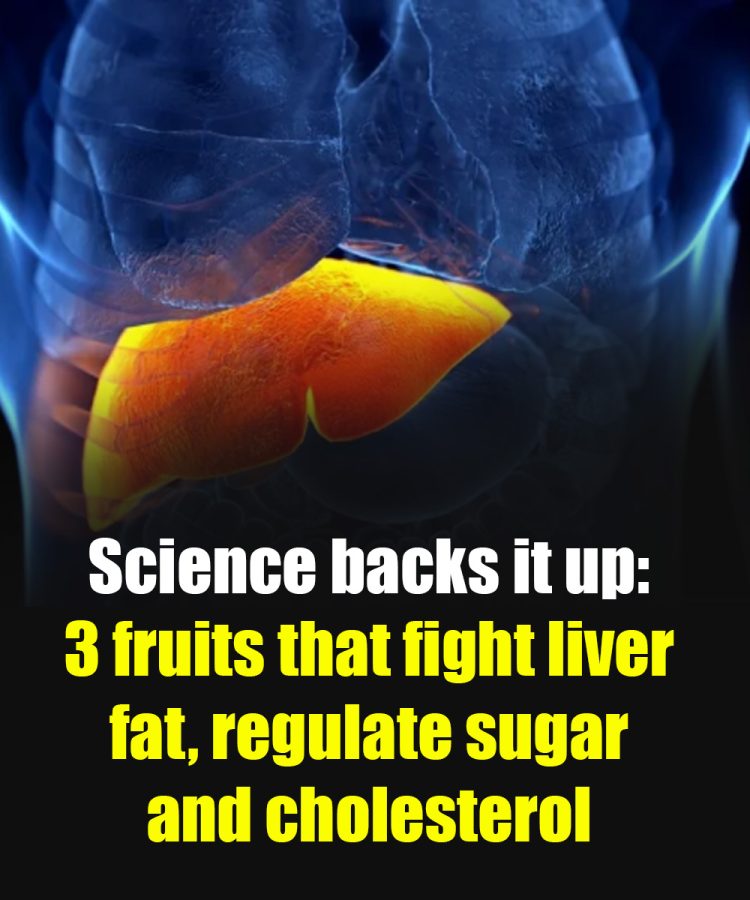Non-alcoholic fatty liver disease (NAFLD), which affects 25-35% of adults according to the World Health Organization (2025), is a silent condition that can lead to inflammation, fibrosis, or cardiovascular problems if left unaddressed. Fat accumulation in the liver, along with sugar and cholesterol imbalances, is linked to diets high in processed sugars and fats.
However, nature offers powerful solutions: certain fruits, loaded with antioxidants, fiber, and bioactive compounds, can reverse these problems. Recent studies, such as one in Nutrients (2025), highlight that a diet rich in specific fruits reduces liver fat by 10-15% in 12 weeks.
Here, we explore three science-backed fruits—blueberries, apples, and avocados—that fight fatty liver disease, stabilize glucose, and improve cholesterol profiles, with ideas for including them in your daily routine and tips for a healthy approach.
Blueberries: Little Giants Against Fatty Liver Disease
Blueberries, with their vibrant color, are a nutritional treasure that goes beyond their flavor. Their richness in anthocyanins, a type of antioxidant, makes them an effective weapon against fatty liver disease and metabolic imbalances.
How They Work
A study in the Journal of Functional Foods (2025) showed that consuming 150 g of blueberries daily for 8 weeks reduced liver fat by 12% in patients with NAFLD, as measured by ultrasound. Anthocyanins inhibit lipogenesis (fat formation) and improve lipid oxidation in the liver. Additionally, they stabilize blood sugar by improving insulin sensitivity by 10%, according to Diabetes Care (2024), and lower LDL (“bad”) cholesterol by 7% thanks to their soluble fiber, according to Lipids in Health and Disease (2025).
Additional Benefits
Blueberries protect the liver from oxidative stress, a key factor in the progression of NAFLD, by neutralizing free radicals. They also reduce systemic inflammation, which benefits cardiovascular and metabolic health.
On Your Table
Add half a cup (75 g) of fresh or frozen blueberries to your breakfast, such as in a smoothie with spinach and Greek yogurt, or sprinkle them on oatmeal. For a snack, combine them with almonds. Eat them 4-5 times a week for consistent results. Choose organic blueberries to avoid pesticides, and avoid sugary juices that lose fiber.
Apples: Fiber and Polyphenols for a Healthy Liver
The apple, a kitchen classic, is much more than an everyday fruit. Its combination of pectin (soluble fiber) and polyphenols makes it an ally for cleansing the liver and regulating metabolic markers.
Scientific Evidence
A trial in the European Journal of Nutrition (2025) found that eating a medium apple (180 g) daily for 12 weeks reduced liver fat by 10% and triglycerides by 15% in overweight people. Pectin traps fat and cholesterol in the intestine, preventing their absorption, while polyphenols, such as quercetin, protect liver cells from oxidative damage. Apples also stabilize glucose by slowing carbohydrate digestion, according to the American Journal of Clinical Nutrition (2024).
More than just a snack
In addition to their impact on the liver, apples promote satiety, helping with weight control, a key factor in NAFLD. Their low glycemic index makes them ideal for diabetics, and their effect on HDL (“good”) cholesterol supports heart health.
Eating Ideas
Eat a whole apple (with the peel, where the polyphenols are) as a mid-morning snack or dessert. Bake them with cinnamon for a healthy treat, or grate them into salads with carrots and walnuts. Aim for 1-2 apples a day, preferably varieties like Granny Smith or Fuji, which are rich in fiber. Avoid sugary compotes that lose nutrients.
Avocados: Healthy Fats for Your Metabolism
Avocados, although often considered a “caloric luxury,” are an exceptional fruit for liver and metabolic health. Its monounsaturated fats, fiber, and vitamin E make it a superfood that fights fatty liver disease and balances cholesterol and blood sugar.
What the Science Says
A study in Liver International (2025) showed that consuming half an avocado (70 g) daily for 10 weeks reduced liver fat by 11% and improved liver enzymes (ALT, AST) by 15% in patients with NAFLD. Monounsaturated fats lower liver triglycerides, while fiber regulates LDL cholesterol by 8%, according to the Journal of the American Heart Association (2025). Additionally, avocado improves insulin sensitivity, stabilizing glucose, according to Diabetes Research and Clinical Practice (2024).
Hidden Benefits
Avocado reduces liver inflammation thanks to its vitamin E, an antioxidant that protects liver cells. It also supports moderate weight loss, crucial for reversing NAFLD, by promoting satiety and reducing cravings.
How to Enjoy It
Incorporate half an avocado daily on whole-wheat toast with tomato, in salads with spinach and lemon, or as a base for a dip with plain yogurt. Use it instead of mayonnaise or butter for a healthy touch. Eat it 3-5 times a week, choosing ripe but firm avocados. Limit your intake if you’re looking to reduce calories, as half an avocado provides about 120 kcal.
Integrating These Fruits into Your Life
see continuation on next page
